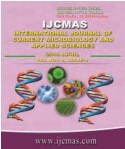


 National Academy of Agricultural Sciences (NAAS)
National Academy of Agricultural Sciences (NAAS)

|
PRINT ISSN : 2319-7692
Online ISSN : 2319-7706 Issues : 12 per year Publisher : Excellent Publishers Email : editorijcmas@gmail.com / submit@ijcmas.com Editor-in-chief: Dr.M.Prakash Index Copernicus ICV 2018: 95.39 NAAS RATING 2020: 5.38 |
Nitrogen is the major nutrient element required for the plant growth and development. In rice, development of varieties with improved nitrogen use efficiency will reduce the nitrogen fertilizer application. This study was investigating the genotypic differences in photosynthetic nitrogen use efficiency, nitrogen use efficiency, yield and yield related traits of 12 different rice genotypes under two different nitrogen levels viz., T1 and T2. Different physiological and agronomical characters were measured in selected 12 genotypes, growing in field. The photosynthetic rate was recorded higher (23.3 μmol CO2 m-2 s-1) with rice genotype Sampada. Efficiency parameters including Photosynthetic Nitrogen Use Efficiency and Harvest Index were studied in order to determine NUE. Chlorophyll content was recorded maximum in vegetative stage under 100% RDN and in reproductive stage under T1 and T2 in NUE genotype of Vardhan and minimum in low NUE genotype Sampada x Jaya/3 under T1 and T2 treatments. Total Dry Matter, grain yield and leaf nitrogen content were higher in high NUE genotype Vardhan. High chlorophyll content in case of Vardhan under low nitrogen content support their higher grain yield and total dry matter content. The Nitrogen Use Efficiency (7.11) and photosynthetic nitrogen use efficiency (12.50) were lower when treated with 100% of recommended Nitrogen. The maximum average grain yield of 824 g m-2 was registered in Vardhan genotype.
 |
 |
 |
 |
 |